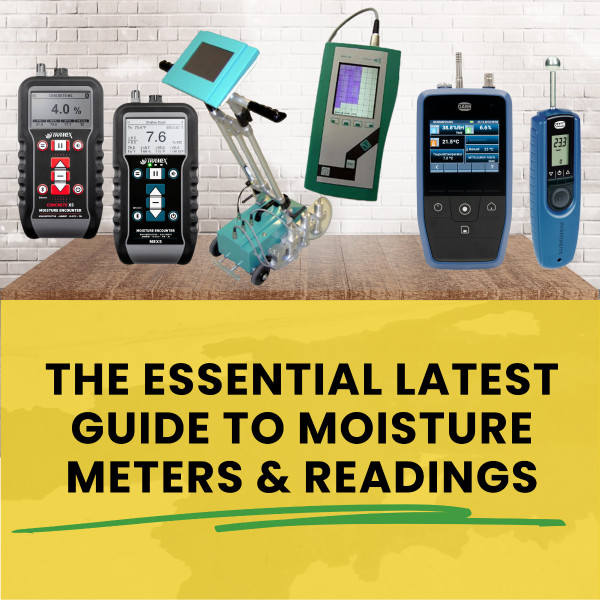The Professional's Guide to Moisture Meters in Australia
Moisture is one of the most destructive forces in buildings — silently causing mould, decay, and structural damage. For professional restorers, builders, and inspectors, moisture meters are essential tools to detect, measure, and validate moisture levels in concrete, timber, gyprock, and other building materials.
With the release of the AS-IICRC S500:2025 standard in Australia, accurate moisture measurement is no longer optional — it’s a requirement for professional practice. In this guide, we’ll break down how moisture meters work, the difference between invasive and non-invasive testing, and what “safe readings” actually look like for common building materials.
How Moisture Meters Work
Moisture meters are designed to detect and quantify water inside building materials. They work on three key measurement scales:
- Relative Scale – Provides readings in digits, useful for comparing “wet” vs “dry” or “affected” vs “unaffected” areas.
- Equivalent Scale – Converts readings into weight percentage (%MC), calcium carbide equivalent (CM%), or wood moisture equivalent (WME).
- Absolute Scale – Provides the most accurate percentage of true moisture content, often using microwave or conductivity-based testing.
These scales are critical for restorers, as insurance reports and drying validation require quantifiable, verifiable data — not guesswork.
Invasive vs. Non-Invasive Testing
- Non-Invasive: Uses electromagnetic sensors to scan materials without damage. Ideal for fast surveys across concrete slabs, gyprock walls, or timber floors.
- Invasive: Uses pins, probes, or insulated rods inserted into the material. Delivers precise depth readings but leaves small entry points. Often essential for timber framing, concrete subfloors, or block walls.
The best practice is to start with non-invasive scanning and confirm results with invasive testing for accuracy.
Moisture Testing Methods by Material
|
Material |
Non-Invasive Testing |
Invasive Testing |
Australia /Manufactures Standard |
|---|---|---|---|
|
Concrete |
- Relative scale (digits) |
- Hygrometer for RH & Temp (≤75% RH at ambient temperature) |
≤2–3% CM or 3.5-4.5 WT% or ≤75% RH at ambient temperature |
|
Timber |
- Relative digits |
- Pin meters with WME correction |
10–15% MC (Pine frames) |
|
Gyprock |
- Relative digits |
- Pin meter calibrated to gyprock |
≤0.5% MC |
|
Block / Stone / Brick Walls |
- Relative digits (surface scan) |
- Brass/stainless brush pins |
≤75% RH (internal probe) |
|
Carpet |
N/A |
- Relative digits (8–12) on invasive building setting |
8–12 (relative scale) |
Understanding Measurement Scales
Each scale has its purpose:
- Relative (Digits): Good for quick comparisons but not scientifically verifiable.
- Equivalent (%MC or CM%): Useful for practical assessment and cross-material comparisons.
- Absolute (%): The gold standard for documentation, claims, and compliance with AS-IICRC S500:2025.
Timber Calibration & Species Correction
Not all timber is created equal. A timber moisture meter with species correction is essential for accurate readings. For example:
- Pine frames: 10–15% MC is safe.
- Hardwoods: Require correction for density and specific gravity.
Failing to adjust for species can lead to false high or low readings that compromise reports and drying validation.
Safe Readings: What Do They Look Like?
- Concrete slabs: ≤2–3% moisture or ≤75% RH.
- Timber framing: 10–15% MC.
- Gyprock: ≤0.5%.
- Carpets: 8–12 digit scale (relative).
These ranges are widely accepted across the Australian restoration industry and align with AS-IICRC S500:2025 drying standards.
Why Readings Can Be Wrong
Even the best meters can give misleading results:
- Metal elements (corner beads, screws, framing) can cause false positives.
- Temperature fluctuations can distort readings unless corrected.
This is why multi-tool verification — thermal imaging, borescopes, invasive meters, and hygrometers — is critical to paint the full picture of what is occurring within a building.
Leading Moisture Meter Brands in Australia
Choosing the right brand is about more than preference — it’s about matching the tool to the job. The following leading brands are widely used in the Australian restoration, construction, and flooring industries:
|
Brand |
Strengths |
Popular Models |
Best For |
|---|---|---|---|
|
Gann (Germany) |
High precision, long service life, excellent timber species calibration |
BL Compact B2 (non-invasive), BL A Plus with M 18 Ram In Sensors (pin-type with probes) |
Restoration contractors, timber flooring installers needing accurate %MC |
|
Trotec (Germany) |
Wide range from entry-level to advanced modular systems |
T660 (pinless for wall moisture), T3000 (multi-probe modular kit) |
Water damage restoration, building inspectors requiring flexibility |
|
Tramex (Ireland) |
Market leaders in concrete and flooring moisture testing |
CMEX5, Tramex Flooring Inspection Kit |
Flooring contractors and concrete slab testing prior to installation |
At Restore Solutions, we aim to supply all these leading brands across Australia, ensuring professionals have access to the right tools for any project.
Australia’s New Standard: AS-IICRC S500:2025
In 2025, Australia formally adopted the AS-IICRC S500:2025, a localised version of the international ANSI/IICRC S500 water damage restoration standard.
- Developed by Standards Australia, IICRC, and RIA Australasia
- Provides science-based protocols for moisture detection, drying verification, and documentation
- Tailored to Australian construction practices and WHS regulations
- Expected to be adopted by the insurance industry as a compliance benchmark
This standard replaces inconsistent practices and sets a clear national reference for restorers, builders, and insurers.
Who Else Relies on Moisture Meters?
While moisture meters are essential for the restoration industry, they’re also critical tools in several other Australian industries where water content can make or break performance:
- Flooring & Construction – Builders and flooring installers use concrete moisture testing to ensure slabs are within safe RH levels before laying timber, vinyl, or carpet. Installing over a wet slab can lead to costly failures.
- Timber & Joinery – Sawmills, furniture makers, and carpenters depend on invasive timber meters with species correction to prevent warping, cracking, or decay in finished products.
- Painting & Coatings – Professional painters check substrate moisture before applying coatings, as excess moisture causes blistering, bubbling, and premature failure.
- Agriculture & Landscaping – Farmers and turf managers use soil and timber meters to monitor irrigation efficiency and prevent root rot or structural decay in posts and frames.
- Heritage Conservation – Conservators and architects rely on non-invasive meters to monitor rising damp, salt attack, and moisture ingress in heritage buildings without damaging fragile materials.
These industries share one common requirement: accurate, defensible data. The same principles outlined in the AS-IICRC S500:2025 apply across sectors — moisture measurement must be scientific, repeatable, and verifiable.
Choosing the Right Meter for Your Needs
When selecting a moisture meter, ask:
- What material am I testing? (Concrete, timber, gyprock, masonry, carpet)
- Do I need quick scanning or scientific validation?
- Am I reporting to insurers under AS-IICRC S500:2025?
- Do I need species correction for timber?
For professional restorers, the best setup is a multi-tool kit:
- Thermal camera for fast scanning.
- Non-invasive meter for wide-area checks.
- Invasive meter for depth verification.
- Hygrometer for concrete and in-depth testing.
This layered approach ensures accuracy, compliance, and confidence in reporting.
Moisture meters are more than inspection tools — they’re the backbone of scientific, defensible restoration in Australia. By understanding how each scale works, applying species and material corrections, and aligning with AS-IICRC S500:2025, restorers can deliver data-driven results that insurers trust and clients rely on.
At Restore Solutions, we supply the industry’s leading moisture meters and kits, backed by expert guidance. Whether you’re restoring flood damage, investigating mould, or validating drying, the right tool makes all the difference.
Explore our full range of professional moisture meters here.
Recent Posts
-
Ten Years of Restore Solutions: Innovation for Restorers
In 2015, Restore Solutions entered the market with one clear purpose — to help restoration professio …2nd Dec 2025 -
The Ultimate Battery Operated Power Scrubber for Restoration Professionals
Less Elbow Grease, More Results: Meet the Battery-Powered Scrubber That Does the Hard Work for You S …17th Nov 2025 -
Choosing the Right Cleaning Chemicals in Restoration: Work Smarter, Work Safer
Chemical safety isn’t an optional extra in restoration — it’s the foundation of professional, consis …9th Nov 2025




